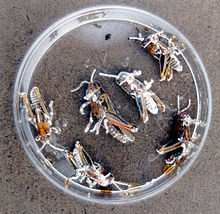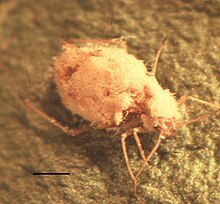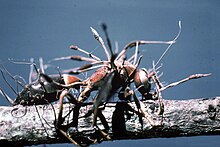Entomopathogenic fungus
This article has multiple issues. Please help improve it or discuss these issues on the talk page. (Learn how and when to remove these template messages)
|
An entomopathogenic fungus is a fungus that can kill or seriously disable insects.

They don't need to enter into the body through oral ingestion or intake. Entomopathogenic fungi directly penetrates through the exoskeleton of the insect and damage the insect.
Typical life cycle

These fungi usually attach to the external body surface of insects in the form of microscopic
Groups

The entomopathogenic fungi include
Fungi may also attack and kill other
pests.Pest management
Since they are considered natural mortality agents and environmentally safe, entomopathogenic fungi for
Production
Most entomopathogenic fungi can be grown on artificial media. Some require complex media, while others, like Beauveria bassiana and exploitable species in the genus Metarhizium, can be grown on starch-rich substrates such as rice or wheat grains.
Virulence
Entomophthorales are often reported as causing
Host relationship chemical cues
Entomopathogenic fungi such as
See also
- Biopesticide
- Entomopathogenic nematode
- LUBILOSA and Desert locust for more on use of Metarhizium as a biological insecticide
References
- PMID 24031896.
- S2CID 83558063.
- ^ Vandenburg, J.D., Ramos, M. & Altre, J.A. (1998) Dose –response and age- and temperature-related susceptibility of the diamondback moth (Lepidoptera: Plutellidae) to two isolates of Beauveria bassiana (Hyphomycetes: Moniliaceae). Environmental Entomology, 27, 1017–1021.
- ^ Hughes, W.O.H., Petersen, K.S., Ugelvig, L.V., Pedersen, D., Thomsen, L., Poulsen, M. et al. (2004) Density-dependence and within-host competition in a semelparous parasite of leafcutting ants. BMC Evolutionary Biology, 4, 45.
- ^ Lord, J.C. (2001) Response of the wasp Cephalonomia tarsalis (Hymenoptera: Bethylidae) to Beauveria bassiana (Hyphomycetes: Moniliales) as free conidia or infection in its host, the sawtoothed grain beetle, Oryzaephilus surinamensis (Coleoptera: Silvanidae). Biological Control, 21, 300–304.
- ^ Myles, T.G. (2002) Alarm, aggregation, and defense by Reticulitermes flavipes in response to a naturally occurring isolate of Metarhizium anisopliae. Sociobiology, 40, 243–255.
External links
- Fungal control of insect and mite pests, from the University of Warwick
- Services and History of the ARSEF Collection
- ARS Collection of Entomopathogenic Fungal Cultures (ARSEF)
- Entomopathogenic Fungi as Effective Insect Pest Management Tactic: A Review, Hafiza Tahira Gul, Shafqat Saeed, Fawad Zafar Ahmad Khan, Applied Sciences and Business Economics, Volume 1, Issue 1, [10-18] June, 2014.
